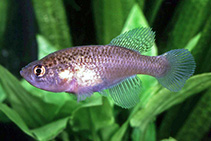| Family: |
Rivulidae (Rivulines), subfamily: Cynolebiinae |
| Max. size: |
8.34 cm SL (male/unsexed); 5.52 cm SL (female) |
| Environment: |
benthopelagic; freshwater, non-migratory |
| Distribution: |
South America: Upper Tocantins River basin in Brazil. |
| Diagnosis: |
Dorsal soft rays (total): 17-22; Anal soft rays: 19-23. Wide basihyal in both sexes. Females with 1-2 black precaudal blotches. Supraorbital neuromasts 21-22. Dorsal-fin rays 20-22 in males, 17-19 in females; anal-fin rays 21-23 in males, 19-21 in females; caudal-fin rays 33-34. Caudal and pectoral fins rounded. Filamentous rays on anal fin of male lacking. Contact organs on scales of body and head of male present. Snout gently pointed with lower jaw slightly elongated (Ref. 40938). |
| Biology: |
Bottom spawner, 4 months. Difficult to maintain in aquarium (Ref. 27139). |
| IUCN Red List Status: |
Critically Endangered (CR); Date assessed: 07 November 2018 (B2ab(iii)) Ref. (130435)
|
| Threat to humans: |
harmless |
Source and more info: www.fishbase.org. For personal, classroom, and other internal use only. Not for publication.

